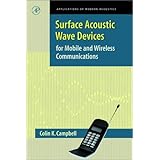
Average Reviews:

(More customer reviews)This book outlines the fundamentals of SAW design and also gives excellent insight for mobile communications. I found the worked examples in the book exceptionally good and easy to understand. The author has given the reader an exhaustive set of references at the end of each chapter. This book is a "must read" for any communication design engineer involved with wireless devices.
Click Here to see more reviews about: Surface Acoustic Wave Devices for Mobile and Wireless Communications
Written for readers with or without surface acoustic wave (SAW) experience, this book covers a wide range of SAW filter- and device-design techniques as well as applications to mobile and wireless circuitry. It provides numerous references and worked examples on SAW devices to highlight various design aspects, and contains illustrations from many leading electronic companies around the world. The first half of the book covers the principles of SAW devices. The secondhalf focuses on applications to the mobile/wireless field, including SAW devices for antenna duplexers, RF and IF filters for cellular cordless phones, front-end filters for wireless transceivers, fixed and tunable oscillators, filters for on-board satellite communications, as well as coding and convolvers for indoor/outdoor spread-spectrum communications.Surface Acoustic Wave Devices for Mobile and Wireless Communications serves as an excellent sourcebook for engineers and designers with some SAW background, or for technical staff with no prior knowledge of SAW devices who need to know how this technology can help their products. It can be used as a textbook for senior and graduate students engaged in the study of signal processing techniques and systems for mobile communications.Key Features* First SAW text applied to mobile and wireless communications* Written by an award-winning researcher with over 20 years of SAW device experience* Presents the theory and design of major SAW devices for mobile/wireless communications as applied to some of the major telecommunication standards* Accessible to both engineering and scientific readers with or without prior SAW device knowledge





















